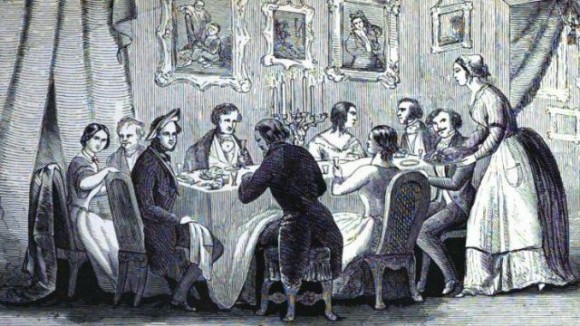A Gilded Age Christmas Dinner
December 24, 2011 (This blog is the final in a short series of snapshots that illustrate how Americans in the late 19th and early 20th centuries came upon or celebrated certain holiday traditions.)
(This blog is the final in a short series of snapshots that illustrate how Americans in the late 19th and early 20th centuries came upon or celebrated certain holiday traditions.)
Dinner during the latter half of the 19th century was executed with all-out Victorian extravagance. The ritual involved many courses, formal tableside service, up to eight forks and knives on the place setting, and several hours. Every detail was seriously considered. One 1865 handbook of dining etiquette made some of the following suggestions to ensure a perfect dinner party:
“Let your dining room be brilliantly lighted, your cloth perfectly clean and the temperature of the room from 16 to 18 degrees Réaumur.”
“Let the tea not be too strong; the hot toast well buttered; and the punch perfectly mixed.”
“Let the number of your guests never exceed twelve, so that conversation may constantly remain general.”
“Let no one leave before eleven, but let every one be in bed by midnight.”
“Let the coffee be very hot, and the liqueurs of first quality.”
Christmas would be a time of uniting the most sumptuous fare money could buy and the most extravagant dinner service one’s place in society could permit. We’ll let a couple Gilded Age holiday menus speak for themselves:
Just a few selections from the massive 1888 Christmas dinner menu at the Murray Hill Hotel in New York City:
The Ladies Home Journal suggested a menu in 1897 that is a bit less, shall we say, meat-focused than the above. Here it is in full:
The refrigerated long-haul truck wasn’t invented until the 1930s, but the Gilded Age elite still had access to fine foods the lower classes didn’t. Thanks to an expanding railroad network, produce came more quickly than ever from warmer states; domestic meats and game were widely available for those who could afford it; and fine, imported European wine and spirits were a staple, since “A dinner, no matter how recherché, how sumptuous, will never go off well if the wine is bad…” Other classic luxury products included coffee, chocolate, oysters, and tea.
Resources:
The Handbook of Dining, or Corpulency and Leanness Scientifically Considered, by Brillat-Savarin, 1865. (via “A Gilded Age Dinner,” Duncan A. McKee, New England Antiques Journal, September 2005) “Tempting the Gourmands: Hotel Menus Appealing to Eye and Palate,” The New York Times, December 26, 1888 (p. 8) (via Food Timeline) Savory Suppers & Fashionable Feasts: Dining in Victorian America, Susan Williams. Pantheon Books: New York, 1985 (via Food Timeline)